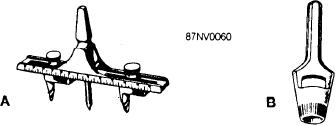
operating conditions, and mechanical features (bolting,
cool, the pipe contracts more than the fitting, and a loose
joint results.
flange shape, and so forth) of the flanged assembly.
Since these factors are interdependent, carefully
Use good lubricant or pipe dope to overcome
examine and weigh all factors for each installation.
friction and make it easier to assemble parts. Paint the
pipe dope on the male thread only. This is to keep it from
Gasket cutters are made to cut gaskets from sheets
getting into the pipe and damaging valve seats and other
of gasket material such as paper, cork, rubber, leather,
parts of the system.
and asbestos and fiber composition. One type of gasket
cutter is shown in view A of figure 16-21. To use this
White lead or red lead is generally used to lubricate
cutter, place the gasket material on a wood surface and
and make up threaded joints in plumbing work. A
adjust the two cutters-one for the inside cut, the other
special paste made from oil and filler material is used
for the outside cut. Place the shank in a brace and insert
on some low-pressure steam lines. A compound or
the center pin in the gasket material and rotate the brace,
mixture of white lead and spar varnish is recommended
thereby forming the gasket. If the gasket is to have
for freshwater systems.
boltholes, punch them out with a gasket punch of the
In assembling the joint, you will have to depend on
type shown in view B of figure 16-21. These punches
feel to tell whether the male and female threads are
are available in various sizes. Punching the boltholcs a
properly started. Make up the joint by hand and turn the
bit larger than the bolts will eliminate a tendency toward
fitting as far as it will go. A few turns with the proper
bulging along the bolt circumference. The center
size pipe wrench should complete the job. It may be
material should be cut so that the inside diameter is the
necessary to use a large wrench or a wrench handle
same as the inside diameter of the pipe at the flange
extension when you are taking down lines with stubborn
surface.
joints. But, an oversize wrench used to assemble the
joint may crack the walls of the fitting.
Gaskets may also be cut with shears, snips, or a
sharp knife. When using any of these tools, you must
mark the material appropriately before cutting out the
Flanged Joints
gasket. You can mark the gasket by laying the material
over the flange and marking the cutting limits by light
The methods used to join a flange to a pipe are the
blows with a ball peen hammer. (This procedure should
same as those used with other fittings; that is, the flange
be used only for MARKING the gasket; do not cut the
may be welded, brazed, or screwed to the pipe. Male
gasket completely by this procedure.)
and female flanged joints are not generally used in
You can also mark a gasket by chalking the face of
steam piping. The initial cost of these joints is high, and
the flange, laying the gasket material over the flange,'
it is difficult to disconnect them to replace gaskets.
However, this type of joint is still used in hydraulic and
and applying pressure to the material. This will transfer
other high-pressure lines, and for steel piping
the chalked impressions of the flange to the material.
connections in high-temperature turbine lubrication
Gaskets may also be laid out using the procedure
systems. To get enough play in the line to break the joint,
previously described for laying out a flange.
you will have to slack a slip joint or spring the line.
FLANGE MAKEUP.--Much of the trouble
Flange faces must be in perfect alignment and free
experienced with leaky joints in piping is due to poor
from all dirt and grit, which might cause trouble in the
alignment or improper allowance for expansion.
joint. In some instances, you may need to build up
Though you won't be able to correct expansion
eroded areas of the flange by welding. Then the flange
problems in existing piping, you can correct alignment
faces will need to be refaced before you can make a
satisfactory joint. However, a thorough cleaning job
will be enough for most flanges.
All faced and grooved flanges are assembled with
gaskets. When choosing a gasket, always refer to the
applicable system blueprint for the correct gasket. If the
applicable blueprint is not available, refer to
MIL-STD-777 or MIL-STD-438 to select a proper
gasket. If none of these references are available, your
Figure 16-21.--Gasket cutter and gasket punch.
gasket choice will depend on the characteristics,
16-19

